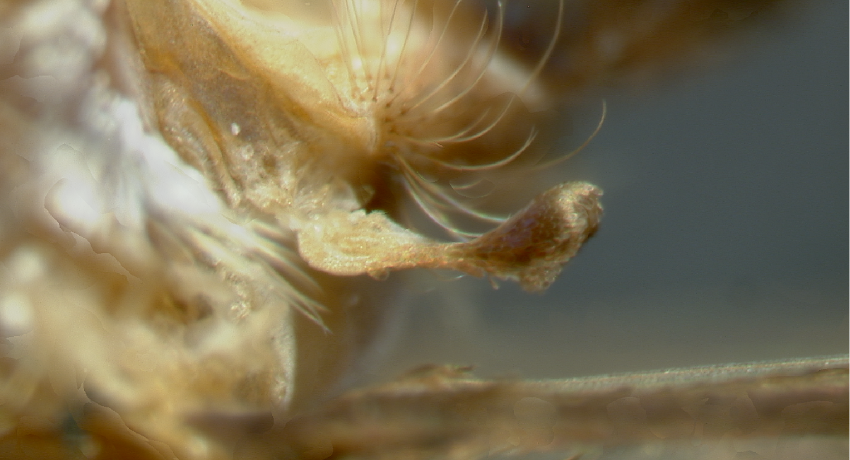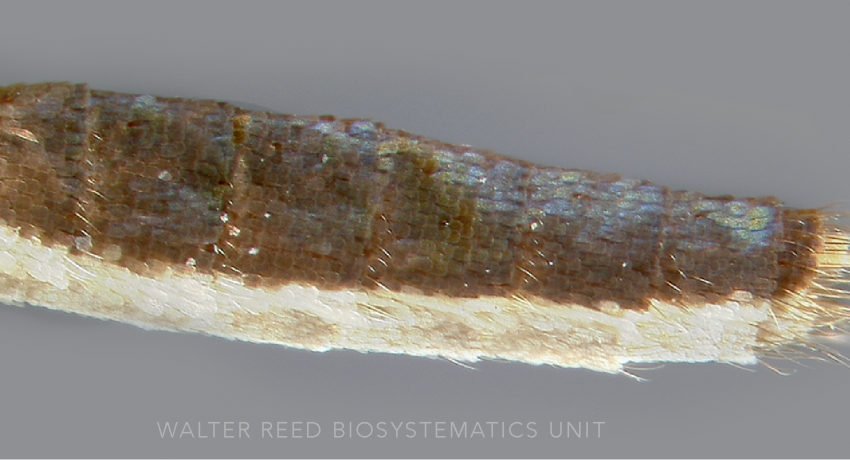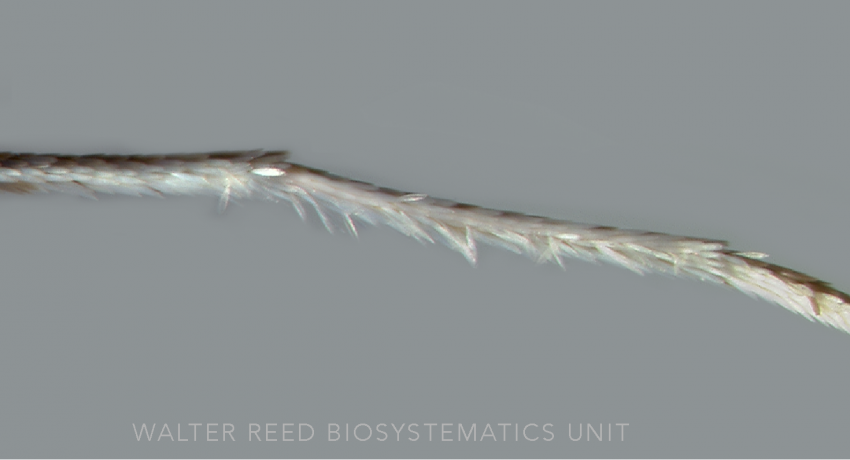NEOTROPICAL REGION
Generic abbreviation: On.
Type species: Dendromyia personata Lutz (In Bourroul, 1904).
Etymology: Derived from the Greek Oneiros (m.), dream or vision.
The Neotropical genus Onirion comprises seven species: On. aenigma Harbach, On. brucei (del Ponte & Cerqueira), On. celatum Peyton & Harbach, On. imparis Peyton & Harbach, On. personatum (Lutz), On. regale Peyton & Harbach, and On. sirivanakarni (Duret). Onirion species most closely resemble Wyeomyia species. The long cercal setae arising from the male proctiger are diagnostic characters of Onirion species.
DIAGNOSTIC CHARACTERS (Click photos to view; mouse over and click large photo to zoom in.)
ADULT (illustrated): Head: Head scales broad and flat. Thorax: Silvery-white scales on lower part of head, antepronotum, postpronotum, pleuron and C-I–III. Legs: Ta-II,III with white scales on at least one tarsomere. Abdomen: Abdominal scales broad and flat; dark scales sometimes with slight blue iridescence; terga dark; sterna with distinct white scaling in a well-demarcated line.
LARVA (not illustrated): Thorax: Setae 4-P and 7-T with distinct aciculae on one side; seta 11-T short with distinct sharp branches. Terminal segments: Pecten filamentous; numerous setae along length of siphon.
TAXONOMIC KEYS
Harbach & Peyton 2000
![]()
WRBU – Genera – Global – Larva
![]()
WRBU – Genera – Neotropical – Adult
![]()
WRBU – Genera – Neotropical – Larva
Exemplar DNA sequences
Onirion sp. stA COI: MF172340–44
BIONOMICS
Immatures
Onirion immatures are found in water collections in ground bromeliads, and bamboo habitats. Larvae of On. imparis were collected in bamboo internodes in the Yasuní National Park, eastern Ecuador.
Adults
Closely associated with tropical forest habitats, the bionomics of many species remain elusive. Adults are diurnal—ovipositing and host-seeking during the day— and several Onirion species will attack people in the forest. Onirion personatum are often collected in baited CDC traps in the southeastern Atlantic forest, Brazil, suggesting it would also be attracted to large mammals. In São Paulo, Brazil, On. personatum was collected laden with eggs of the human botfly, Dermatobia hominis.
*Associated pathogens: This list reports bacteria, viruses, and parasites recovered from, or experimentally passed through this species, and does not imply field vector status.
IMPORTANT REFERENCES (full citations below)
Harbach & Peyton 2000: 118 (as genus, key, phylogeny)
Harbach et al. 2007b (phylogeny)
Motta et al. 2007 (molecular phylogeny)
VALID SUBGENERA
None
CURRENT GENERIC SYNONYMS
None
CITED REFERENCES
Bourroul, C. (1904). Mosquitos do Brasil. Faculdade de Medicina da Bahia, 78pp.
Harbach, R.E., & Peyton, E.L. (2000). Systematics of Onirion, a new genus of Sabethini (Diptera: Culicidae) from the Neotropical region. Bulletin of the Natural History Museum London (Entomology), 69, 115–159.
Harbach, R.E., Huong, V.E., & Kitching, I.J. (2007b). Systematics of Kimia, a new genus of Sabethini (Diptera: Culicidae) in the Oriental Region. Proceedings of the Entomological Society of Washington, 109(1), 102–120.
Motta, M.A., Lourenço-de-Oliveira, R., & Sallum, M.A.M. (2007). Phylogeny of genus Wyeomyia (Diptera: Culicidae) inferred from morphological and allozyme data. Canadian Entomologist, 139(5), 591–627.
CITE THIS PAGE
Walter Reed Biosystematics Unit (Year). Onirion genus page. Walter Reed Biosystematics Unit Website, http://wrbu.si.edu/vectorspecies/genera/onirion, accessed on [date (e.g. 03 February 2020) when you last viewed the site].







